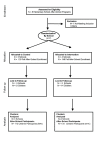HOP'N after-school project: an obesity prevention randomized controlled trial
- PMID: 21144055
- PMCID: PMC3022613
- DOI: 10.1186/1479-5868-7-90
HOP'N after-school project: an obesity prevention randomized controlled trial
Abstract
Background: This paper reports the primary outcomes of the Healthy Opportunities for Physical Activity and Nutrition (HOP'N) after-school project, which was an effectiveness trial designed to evaluate the prevention of childhood obesity through building the capacity of after-school staff to increase physical activity (PA) and fruit and vegetable (FV) opportunities.
Methods: We conducted a three-year, nested cross-sectional group randomized controlled effectiveness trial. After a baseline assessment year (2005-2006), schools and their after-school programs were randomized to the HOP'N after-school program (n = 4) or control (n = 3), and assessed for two subsequent years (intervention year 1, 2006-2007; intervention year 2, 2007-2008). Across the three years, 715 fourth grade students, and 246 third and fourth grade after-school program participants were included in the study. HOP'N included community government human service agency (Cooperative Extension) led community development efforts, a three-time yearly training of after-school staff, daily PA for 30 minutes following CATCH guidelines, a daily healthful snack, and a weekly nutrition and PA curriculum (HOP'N Club). Child outcomes included change in age- and gender-specific body mass index z-scores (BMIz) across the school year and PA during after-school time measured by accelerometers. The success of HOP'N in changing after-school program opportunities was evaluated by observations over the school year of after-school program physical activity sessions and snack FV offerings. Data were analyzed in 2009.
Results: The intervention had no impact on changes in BMIz. Overweight/obese children attending HOP'N after-school programs performed 5.92 minutes more moderate-to-vigorous PA per day after intervention, which eliminated a baseline year deficit of 9.65 minutes per day (p < 0.05) compared to control site overweight/obese children. Active recreation program time at HOP'N sites was 23.40 minutes (intervention year 1, p = 0.01) and 14.20 minutes (intervention year 2, p = 0.10) greater than control sites. HOP'N sites and control sites did not differ in the number of FV offered as snacks.
Conclusions: The HOP'N program had a positive impact on overweight/obese children's PA and after-school active recreation time.
Trial registration: NCT01015599.
Figures
References
-
- Capizzano J, Tout K, Adams G. Child care patterns of school-age children with employed mothers. Washington, D.C., Urban Institute; 2000.
-
- Wirt J, Choy S, Rooney P, Provasnik S, Sen A, Tobin R. The condition of education 2004 (NCES 2004-077) Washington D.C., U.S. Government Printing Office; 2004.
Associated data
LinkOut - more resources
Full Text Sources
Medical



